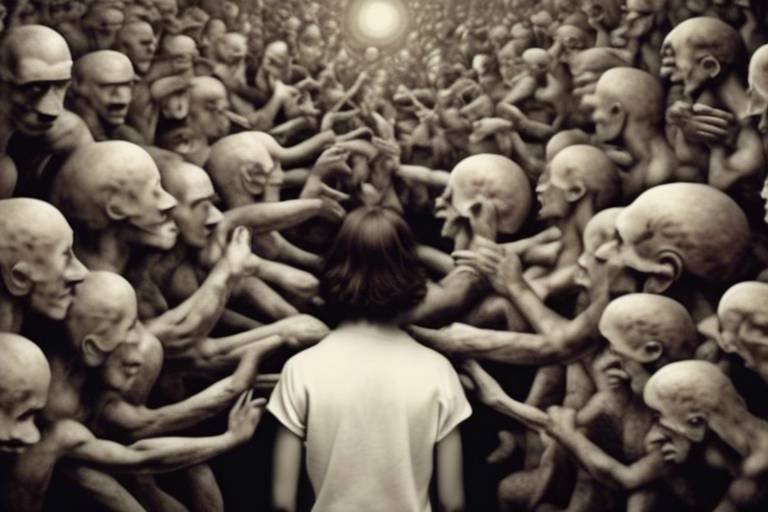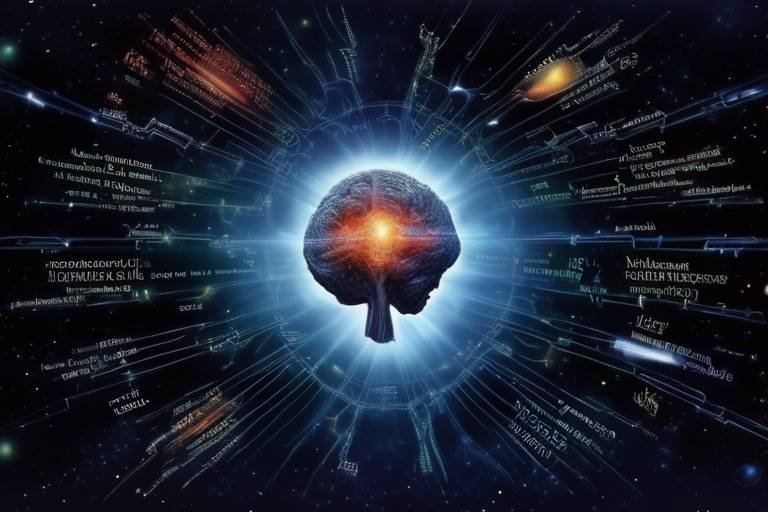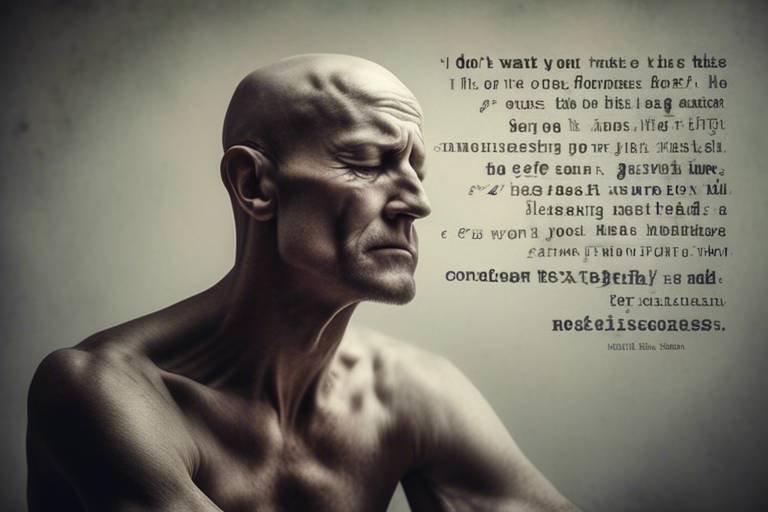Phantom Limb - A Consciousness Puzzle
Have you ever heard of the term phantom limb? It's a fascinating and somewhat eerie phenomenon that occurs when an individual who has undergone an amputation still feels sensations, including pain, in the limb that is no longer there. Imagine waking up one day, looking down at your body, and realizing that a part of you is missing, yet your brain insists that it is still there, alive and kicking. This contradiction between physical reality and sensory perception raises profound questions about our understanding of consciousness and how we perceive our bodies.
Phantom limb sensations can be bewildering. They often manifest as tingling, itching, or even severe pain in the area where the limb used to be. For many amputees, these sensations can be a constant reminder of their loss, creating a complex emotional landscape that intertwines grief with the inexplicable. It's like having a ghost that lingers long after the body has changed. As we delve deeper into this topic, we’ll explore the neurological, psychological, and philosophical aspects that contribute to our understanding of these sensations and the larger implications they hold for the concept of self.
In this article, we will dissect the intricate relationship between the brain and body, the role of neural plasticity in adapting to loss, and the psychological dimensions that shape our experiences of phantom limbs. Furthermore, we will engage with philosophical questions about identity and the nature of consciousness itself. So, buckle up as we embark on this thought-provoking journey into the world of phantom limbs, where the boundaries of body perception and consciousness are intriguingly blurred.
Phantom limb sensations occur when amputees feel sensations or pain in a limb that no longer exists. This section explains the underlying mechanisms and how the brain processes these sensations despite the absence of the limb.
Investigating the brain's role in phantom limb sensations reveals complex neural pathways. This section discusses how the brain's representation of the body contributes to these sensations and the implications for understanding neural plasticity.
Neural plasticity refers to the brain's ability to reorganize itself. Here, we explore how this adaptability can lead to phantom limb sensations and the potential for recovery or adaptation after limb loss.
The brain's sensory maps can shift after an amputation, leading to phantom sensations. This subsection discusses how these maps are formed and restructured in response to changes in the body.
Understanding neural plasticity has significant implications for rehabilitation strategies. This section examines how targeted therapies can help alleviate phantom limb pain and improve outcomes for amputees.
The experience of phantom limbs is not solely physical; psychological factors play a crucial role. This section discusses the emotional and cognitive dimensions of phantom limb sensations.
Phantom limb phenomena raise important philosophical questions about the nature of self and body perception. This section explores how these experiences challenge our understanding of identity and consciousness.
The experience of having a phantom limb can lead to a reevaluation of personal identity. Here, we discuss how these sensations influence an individual’s perception of themselves and their bodily existence.
Phantom limb sensations highlight the complexities of consciousness and the mind-body relationship. This subsection delves into philosophical debates surrounding dualism and materialism in light of these experiences.
- What causes phantom limb sensations? Phantom limb sensations are caused by the brain's representation of the body, which can persist even after a limb has been removed.
- Can phantom limb pain be treated? Yes, various treatments, including physical therapy and mirror therapy, can help alleviate phantom limb pain.
- Are phantom limb sensations common among all amputees? While many amputees experience phantom limb sensations, the intensity and frequency can vary greatly from person to person.

Understanding Phantom Limb Sensations
Phantom limb sensations are a fascinating, albeit perplexing, phenomenon that many amputees experience. Imagine losing a part of your body, yet still feeling it as if it were there. It’s like a ghostly presence that lingers long after the physical limb has vanished. These sensations can range from feelings of warmth or cold to intense pain, known as phantom pain. The brain, in its remarkable complexity, continues to receive signals that it interprets as originating from the missing limb, even though that limb is no longer there. This raises a multitude of questions about how our brains perceive our bodies and the very nature of consciousness itself.
To grasp phantom limb sensations, it's essential to understand the neural mechanisms at play. When a limb is amputated, the brain doesn't merely shut down the areas responsible for processing sensations from that limb. Instead, the brain's representation of the body—often referred to as the "body schema"—remains intact. This body schema is a mental map of where our limbs are and how they feel, created through a lifetime of sensory experiences. When the limb is gone, the brain may misinterpret signals from nearby areas, leading to the sensation that the missing limb is still there. It's like a well-rehearsed play that continues even after the lead actor has left the stage.
Interestingly, phantom sensations can manifest in various ways. Some individuals report a feeling of itchiness in their phantom limb, while others may experience a sense of movement or even the sensation of their phantom limb being in a specific position. This variability makes it clear that the experience is highly subjective and influenced by individual factors, including psychological state and previous experiences with the limb. The brain’s adaptability—its ability to reorganize itself in response to changes—plays a crucial role in these sensations. It’s a bit like rearranging furniture in a room; the layout changes, but the space still feels familiar.
Moreover, the emotional and psychological aspects of phantom limb sensations cannot be overlooked. Many amputees find themselves grappling with feelings of loss, frustration, or even anger about their situation. This emotional turmoil can amplify the sensations they experience, creating a feedback loop that makes the sensations more intense. Understanding this interplay between physical sensations and psychological states is vital for developing effective treatments. Just as a skilled artist knows how to mix colors to create a masterpiece, therapists must blend physical and mental health strategies to help individuals cope with phantom limb sensations.
In summary, phantom limb sensations are a complex interplay of neural, psychological, and emotional factors. They challenge our understanding of body perception and consciousness, raising profound questions about what it means to be human. As we delve deeper into this phenomenon, we uncover not just the mysteries of the brain, but also the intricacies of identity and self-awareness.
- What causes phantom limb sensations? Phantom limb sensations arise from the brain's continued processing of signals that it associates with the missing limb, alongside psychological factors.
- Can phantom limb pain be treated? Yes, various treatments, including medication, physical therapy, and psychological support, can help alleviate phantom limb pain.
- Do all amputees experience phantom limb sensations? No, not all amputees experience these sensations, but studies suggest that a significant percentage do.
- How long do phantom limb sensations last? These sensations can persist for years after an amputation, though their intensity may diminish over time.

The Neuroscience Behind Phantom Limbs
Phantom limb sensations are a fascinating intersection of neuroscience and human experience. When an individual loses a limb, the brain doesn't simply forget about it. Instead, it continues to send signals that can create the sensation of pain or tingling in the absent limb. This phenomenon can be perplexing, but it highlights the brain's remarkable ability to adapt and reorganize itself in response to changes in the body. The brain's representation of the body, often referred to as the body schema, is a dynamic construct that is influenced by sensory input and experiences.
One of the key components in understanding phantom limb sensations is the concept of neural plasticity. This refers to the brain's ability to change and reorganize itself by forming new neural connections throughout life. After an amputation, the areas of the brain that were previously dedicated to the missing limb may become responsive to sensations from other parts of the body. For instance, if a person's arm is amputated, the brain area that once controlled the arm may start to respond to signals from the face or residual limb, leading to the experience of phantom sensations in the missing arm.
To better understand this, let's take a look at how the brain's sensory maps are organized. The brain has a representation of the body's sensory input, often illustrated through a homunculus, which shows how different body parts correspond to specific areas in the brain. Following an amputation, the sensory map can undergo significant changes:
| Body Part | Before Amputation | After Amputation |
|---|---|---|
| Arm | Active sensory representation | Potentially inactive; may respond to other areas |
| Face | Active sensory representation | May become overactive, causing sensations in the phantom limb |
This reorganization can lead to the experience of phantom limb sensations, as the brain attempts to make sense of the signals it receives. The intricate relationship between the body and the brain is evident here; while the limb is gone, the brain's memory of it persists. This persistent memory can lead to sensations that feel very real, despite the absence of the physical limb.
Moreover, the implications of this neural reorganization extend beyond just understanding phantom limb sensations. They also provide insight into rehabilitation strategies for amputees. By leveraging the brain's plasticity, targeted therapies can be developed to help alleviate phantom limb pain. Techniques such as mirror therapy, where patients use a mirror to reflect the movements of their intact limb, can help retrain the brain and reduce discomfort associated with phantom sensations.
In conclusion, the neuroscience behind phantom limbs sheds light on the complex interplay between the brain and body. It challenges our understanding of how we perceive ourselves and illustrates the brain's remarkable adaptability. As we continue to explore these phenomena, we gain deeper insights into the nature of consciousness and the human experience.
- What causes phantom limb sensations? Phantom limb sensations are caused by the brain's continued activity in the areas that once received sensory input from the missing limb.
- Can phantom limb pain be treated? Yes, treatments such as mirror therapy and medications can help alleviate phantom limb pain.
- Is phantom limb sensation common among amputees? Yes, many amputees experience phantom limb sensations, with varying degrees of intensity.

Neural Plasticity and Adaptation
Neural plasticity is an incredible phenomenon that showcases the brain's remarkable ability to adapt and reorganize itself in response to changes in the body. When an individual loses a limb, the brain undergoes a series of adjustments to accommodate this new reality. You might wonder, how does this reorganization happen, and what does it mean for those who experience phantom limb sensations? Well, let's dive into this fascinating world of neural adaptation!
After an amputation, the brain does not simply forget about the missing limb. Instead, it begins to rewire itself, which can lead to the sensation of a phantom limb. This phenomenon is a testament to the brain's resilience and its capacity for change. The areas of the brain that once processed sensory information from the lost limb may start to respond to stimuli from adjacent body parts. For example, if a person loses their arm, the area of the brain that represented the arm might begin to pick up signals from the shoulder or even the chest. This is where things get intriguing: the brain's neural maps are not fixed; they are fluid and can adapt based on experience.
Let’s break this down further. The concept of neural plasticity encompasses several key aspects:
- Functional Reorganization: This is how the brain's neural circuits change in response to injury or loss. The brain's ability to adapt can lead to the emergence of sensations in areas that were not previously associated with the lost limb.
- Compensatory Mechanisms: The brain may develop new pathways to compensate for the loss, allowing the individual to regain some functionality, albeit in a different form.
- Long-Term Changes: Over time, these adaptations can become more permanent, affecting how the brain processes sensory information and experiences.
One of the most compelling aspects of neural plasticity is its potential for recovery. While phantom limb sensations can be distressing, they also highlight the brain's capacity for healing and adaptation. Some studies suggest that engaging in targeted therapies, such as mirror therapy or sensory re-education, can help alleviate phantom pain by retraining the brain to respond differently to these sensations. This means that while the loss of a limb is significant, the brain's adaptability offers a glimmer of hope for recovery and improved quality of life.
In conclusion, the study of neural plasticity and adaptation in the context of phantom limb sensations not only sheds light on the brain's incredible capabilities but also opens up new avenues for rehabilitation. By understanding how the brain reorganizes itself after limb loss, we can develop more effective strategies to help individuals cope with their experiences, ultimately enhancing their sense of self and well-being.
- What are phantom limb sensations? Phantom limb sensations are feelings of pain, discomfort, or other sensations in a limb that has been amputated.
- How does neural plasticity relate to phantom limb sensations? Neural plasticity refers to the brain's ability to reorganize itself, which can lead to the sensation of a phantom limb as the brain adapts to the loss.
- Can phantom limb pain be treated? Yes, therapies such as mirror therapy, medication, and psychological support can help alleviate phantom limb pain.
- Is it possible for the brain to fully adapt after an amputation? While the brain can adapt significantly, some individuals may continue to experience phantom sensations or pain long after the amputation.

Reorganization of Sensory Maps
The phenomenon of phantom limb sensations is intricately linked to the in the brain. When a limb is amputated, the brain does not simply forget about it; instead, it undergoes a remarkable transformation. This transformation is a response to the loss, where the brain's representation of the body, known as the body schema, begins to adapt to the new reality. This adaptation can lead to the experience of sensations, including pain, in a limb that is no longer there.
To understand this process better, it's essential to recognize how the brain maps sensory inputs. Each part of the body corresponds to a specific area in the brain, often referred to as the somatosensory cortex. When a limb is removed, the area of the brain that was once dedicated to processing sensations from that limb does not simply shut down. Instead, it may become activated by adjacent areas of the body. For instance, if an arm is amputated, the sensory area that once received input from the arm might start to respond to signals from the face or the shoulder. This phenomenon is a testament to the brain's incredible plasticity, but it also explains why individuals might feel sensations in a phantom limb.
Research has shown that the brain's ability to reorganize itself can lead to a variety of outcomes for amputees. Some individuals may experience intense phantom pain, while others may feel only mild sensations. The variability in these experiences can be attributed to several factors, including:
- Duration since amputation: The longer the time since the limb was removed, the more the sensory maps may have reorganized.
- Individual differences: Each person's brain is unique, and factors such as age, health, and neurological history can influence how the brain adapts.
- Level of rehabilitation: Engaging in rehabilitation and sensory re-education can help in modifying these sensory responses.
Understanding the reorganization of sensory maps is crucial not only for those experiencing phantom limb sensations but also for developing effective rehabilitation strategies. By utilizing techniques that stimulate the remaining areas of the body, therapists can help to alleviate phantom pain and enhance the quality of life for amputees. For example, mirror therapy, which involves using a mirror to reflect the intact limb, has shown promise in retraining the brain's perception of the missing limb, thereby reducing discomfort.
In conclusion, the reorganization of sensory maps in the brain is a fascinating and complex process that sheds light on how we perceive our bodies. It highlights the brain's adaptability and the intricate relationship between our physical selves and our perceptions. As research continues in this area, we may uncover even more about the ways in which the brain compensates for loss and how we can harness this knowledge to improve the lives of those affected by limb loss.
- What are phantom limb sensations? Phantom limb sensations are feelings of pain or sensation in a limb that has been amputated.
- Why do phantom limb sensations occur? They occur due to the brain's reorganization of sensory maps after the loss of a limb.
- Can phantom limb pain be treated? Yes, various therapies, including mirror therapy and sensory re-education, can help alleviate phantom limb pain.
- How long do phantom limb sensations last? The duration can vary widely; some people may experience them for months or even years after amputation.

Implications for Rehabilitation
The implications for rehabilitation in the context of phantom limb sensations are profound and multifaceted. Understanding how the brain adapts to the loss of a limb can significantly influence therapeutic approaches. For instance, rehabilitation strategies that incorporate neuroplasticity can help reshape the way the brain perceives the missing limb, potentially alleviating phantom pain and enhancing the overall recovery process.
One of the key aspects of rehabilitation involves the use of mirror therapy. This innovative technique leverages the brain's visual perception to create a semblance of movement in the phantom limb. By positioning a mirror in front of the intact limb, patients can visually trick their brain into perceiving movement in the absent limb. This simple yet effective method has shown remarkable results in reducing phantom pain and improving functional outcomes for amputees.
Moreover, targeted sensory re-education can play a crucial role in rehabilitation. This approach involves training the brain to reinterpret sensory signals that may be misfiring due to the absence of the limb. Techniques such as sensory discrimination tasks and graded exposure to various textures can help retrain the brain's sensory maps, ultimately leading to a decrease in phantom sensations.
In addition to these physical therapies, addressing the psychological aspects of phantom limb sensations is equally important. Psychological counseling and support groups can provide emotional relief and coping strategies for individuals grappling with the loss of a limb. Understanding that they are not alone in their experiences can significantly enhance their recovery journey.
To summarize, the implications for rehabilitation in the context of phantom limb sensations are vast and critical. By integrating neuroplasticity, employing innovative therapies like mirror therapy, and addressing psychological needs, rehabilitation can transform the lives of amputees, allowing them to regain a sense of control and improve their overall quality of life.
- What are phantom limb sensations?
Phantom limb sensations are feelings of pain or other sensations in a limb that has been amputated. These sensations can vary from mild tingling to severe pain.
- How common are phantom limb sensations?
Studies suggest that up to 80% of amputees experience phantom limb sensations, making it a common phenomenon.
- Can phantom limb pain be treated?
Yes, various treatments such as mirror therapy, medication, and psychological support can help manage phantom limb pain effectively.
- What role does the brain play in phantom limb sensations?
The brain continues to receive signals from the nerves that once connected to the limb, leading to sensations even after the limb is gone.

Psychological Aspects of Phantom Limbs
The phenomenon of phantom limb sensations extends far beyond mere physical experiences; it intertwines deeply with psychological factors that shape how individuals perceive their bodies and selves. For many amputees, the sensations they experience in their missing limbs can evoke a range of emotions, from confusion and frustration to profound sadness. Imagine waking up one day and feeling a part of you that no longer exists—it's like a ghost haunting your mind, a constant reminder of what has been lost. These feelings can lead to a complex emotional landscape that significantly impacts the individual’s quality of life.
One of the most intriguing aspects of phantom limb sensations is the way they challenge our understanding of identity. The mind often struggles to reconcile the physical absence of a limb with the persistent sensations that accompany it. This dissonance can lead to feelings of disconnection from one's own body, prompting individuals to question their sense of self. How do we define who we are when a part of us feels like it's still there, even though it’s not? This psychological conflict can cause distress, leading some individuals to seek therapy or support groups to better understand and cope with their experiences.
Moreover, the emotional responses to phantom limb sensations can vary widely among individuals. Some may experience chronic pain, while others might feel only tingling or warmth. This variance can be attributed to several factors, including:
- Previous trauma: The emotional history surrounding the limb loss can influence the intensity and nature of phantom sensations.
- Personality traits: Individual differences in coping mechanisms and resilience can affect how one processes the experience.
- Psychological support: Access to mental health resources plays a crucial role in managing the emotional aftermath of limb loss.
Interestingly, research has shown that the way individuals mentally visualize their phantom limbs can also impact their sensations. For instance, some people find relief by engaging in mental imagery exercises, where they visualize their phantom limb moving or being touched. This technique can help bridge the gap between the physical body and the mind, offering a sense of control over the sensations that can feel overwhelming.
In summary, the psychological aspects of phantom limbs encompass a rich tapestry of emotional, cognitive, and identity-related challenges. Understanding these dimensions is not just important for the individuals experiencing them but also for healthcare providers and therapists who aim to offer comprehensive support. As we continue to unravel the complexities of phantom limb sensations, it becomes increasingly clear that addressing the psychological components is just as crucial as treating any physical symptoms.
- What are phantom limb sensations? Phantom limb sensations are feelings that an amputee experiences in a limb that has been removed, such as pain, itching, or warmth.
- Why do phantom limb sensations occur? These sensations occur due to the brain's representation of the body and its ability to adapt after limb loss, often resulting in a disconnect between the mind and body.
- How can psychological factors influence phantom limb sensations? Emotional responses, previous trauma, and personality traits can all affect how an individual experiences and copes with phantom sensations.
- Are there treatments for phantom limb pain? Yes, treatments can include medications, physical therapy, and psychological support, including cognitive behavioral therapy and mental imagery exercises.

Philosophical Implications of Body Perception
The phenomenon of phantom limbs not only captivates neurologists and psychologists but also poses profound philosophical questions about our understanding of self and body perception. When individuals experience sensations in a limb that no longer exists, it challenges the traditional notions of identity and the physical body. How do we define ourselves if a part of us can be perceived despite its absence? This inquiry opens a Pandora's box of existential questions that delve deep into the essence of consciousness and personal identity.
To grasp the philosophical implications, we must first consider the relationship between the body and the mind. The experience of a phantom limb can lead to a reevaluation of what it means to be whole. For many amputees, the sensation of a missing limb can evoke feelings of loss and disconnection, yet simultaneously, it reinforces the idea that our consciousness extends beyond our physical form. This raises the question: is our identity anchored in our physical body, or is it something more fluid and intangible?
Moreover, these sensations illuminate the complexities of the mind-body problem, a philosophical debate that has persisted for centuries. Dualists argue that the mind and body are distinct entities, while materialists contend that everything about consciousness can be explained through physical processes. Phantom limb sensations challenge these perspectives by demonstrating that our mental representations of the body can exist independently of the physical reality. In essence, the brain's ability to create a sensory experience without corresponding physical input suggests that consciousness is not merely a byproduct of our biological makeup but rather a rich tapestry woven from experiences, memories, and perceptions.
Consider the following implications:
- Identity Reconstruction: Individuals with phantom limbs often find themselves grappling with their identity. The persistent sensation of a missing limb forces them to confront their sense of self, leading to a complex interplay between reality and perception.
- Consciousness Expansion: The ability to feel sensations in a non-existent limb suggests that consciousness may extend beyond the physical boundaries of the body, indicating a more profound connection between mind and experience.
- Existential Reflection: The experience of phantom sensations prompts individuals to reflect on the nature of existence itself. It invites introspection about what it means to be human and how we define our being.
As we navigate these philosophical waters, it's essential to recognize that the implications of phantom limb sensations extend beyond the individual. They challenge societal norms and perceptions of disability, inviting a broader conversation about the human experience. Are we defined solely by our physical forms, or do our thoughts, feelings, and perceptions contribute equally to our identity? These questions resonate deeply in contemporary discussions about body image, disability, and the essence of being.
In conclusion, the philosophical implications of phantom limb sensations are vast and multifaceted. They compel us to reconsider our understanding of identity, consciousness, and the intricate relationship between the mind and body. As we continue to explore these phenomena, we may uncover deeper insights into what it truly means to be human, transcending the limitations of our physical existence.
- What are phantom limb sensations? Phantom limb sensations are feelings of sensation or pain in a limb that has been amputated, experienced by many amputees.
- Why do phantom limb sensations occur? They occur due to the brain's representation of the body and its ability to adapt and reorganize itself after limb loss.
- How can understanding phantom limb sensations help in rehabilitation? By understanding the neural and psychological aspects of these sensations, targeted therapies can be developed to alleviate pain and improve recovery outcomes for amputees.
- What philosophical questions do phantom limbs raise? They challenge our notions of identity, consciousness, and the relationship between the body and mind, prompting us to reconsider what it means to be whole.

Identity and the Sense of Self
The experience of having a phantom limb can profoundly influence an individual’s perception of identity. Imagine waking up one day and feeling a presence of something that is no longer there—it's like an echo of a past self that lingers in the mind. For many amputees, these sensations are not just physical; they challenge the very essence of who they are. The body, often seen as a vessel of identity, suddenly becomes a source of confusion and conflict.
When someone loses a limb, they don't just lose a part of their body; they often grapple with the loss of a part of their identity. The brain, which holds onto the memory of the limb, can create a dissonance between the physical body and the mental image of self. This phenomenon raises intriguing questions: If the brain still perceives a limb that no longer exists, what does that say about our understanding of self? Are we merely our physical bodies, or is there a deeper connection between our mind and our sense of being?
Furthermore, the emotional turmoil that accompanies phantom limb sensations can lead to a reevaluation of one’s identity. Many individuals report feelings of frustration, anger, and even grief as they navigate their new reality. The struggle to reconcile the physical loss with the persistent sensations can create a complex emotional landscape. In some cases, individuals may even find themselves mourning the loss of not just a limb but a part of their identity that was intertwined with it.
To illustrate this concept, consider how we often define ourselves through our physical attributes. For instance, think about how many people introduce themselves by mentioning their hobbies, professions, or even their physical abilities. Losing a limb can strip away these identifiers, leading to an existential crisis where one must ask, "Who am I now?" This quest for identity can be both challenging and transformative, as individuals work to reconstruct their sense of self in light of their new reality.
In understanding the identity struggle faced by amputees, it's essential to recognize that the journey is deeply personal. Each person's experience with phantom limb sensations is unique, influenced by their history, personality, and emotional resilience. Some may find strength in their experiences, using them as a catalyst for personal growth, while others may struggle to adapt.
Ultimately, the relationship between phantom limb sensations and identity invites us to reflect on the broader implications of what it means to be human. It challenges us to consider how much of our identity is tied to our physical form and how our minds can shape our sense of self, even in the absence of physical reality. This exploration not only sheds light on the experiences of amputees but also opens up a dialogue about the fluid nature of identity itself.
- What are phantom limb sensations? Phantom limb sensations are feelings of pain or sensations in a limb that has been amputated, often experienced by amputees.
- Why do phantom limb sensations occur? They occur due to the brain's representation of the body, which can still register sensations from a limb that is no longer present.
- Can phantom limb sensations be treated? Yes, there are various treatments available, including therapies aimed at addressing the neurological and psychological aspects of these sensations.
- How do phantom limb sensations affect identity? They can lead to a reevaluation of self, as individuals navigate the loss of a physical part of their identity and the persistent sensations that challenge their sense of being.

Consciousness and the Mind-Body Problem
The phenomenon of phantom limb sensations opens up a fascinating dialogue about the nature of consciousness and its intricate relationship with the body. At its core, the mind-body problem grapples with the question: How do our mental experiences relate to our physical existence? When an individual experiences sensations from a limb that no longer exists, it challenges traditional notions of how we perceive our bodies and ourselves. It raises profound questions about the essence of consciousness: is it merely a byproduct of our physical form, or does it exist independently?
To illustrate this, consider the analogy of a computer. The hardware (the physical components) and software (the programs and data) work together to create a functioning system. If the hardware is damaged, can the software still operate? Similarly, when a limb is lost, does the consciousness that once inhabited that limb still persist? This conundrum is at the heart of the mind-body debate, as phantom limb sensations suggest that consciousness may have a more complex relationship with our physicality than we previously thought.
Philosophers have long debated the implications of this relationship, often falling into two camps: dualists, who argue that the mind and body are distinct entities, and materialists, who believe that everything about the mind can be explained through physical processes. Phantom limb sensations seem to straddle this divide, as they manifest in a physical absence yet evoke strong mental experiences. This phenomenon invites us to reconsider our definitions of identity and existence.
Furthermore, the mind-body problem becomes even more intricate when we delve into the subjective nature of consciousness. Each individual's experience of a phantom limb is unique, shaped by their personal history, emotions, and psychological state. This subjectivity suggests that consciousness is not merely a product of our physical state but is also influenced by our mental frameworks. In this light, the mind-body problem is not just a philosophical quandary but a deeply personal exploration of what it means to be human.
In summary, the relationship between consciousness and the body is a complex tapestry woven from threads of experience, perception, and identity. Phantom limb sensations serve as a powerful reminder of this complexity, challenging us to rethink our understanding of the self. Are we merely our bodies, or is there something more profound at play? As we continue to explore these questions, we may uncover deeper insights into the nature of consciousness itself.
- What are phantom limb sensations? Phantom limb sensations are feelings of pain or other sensations in a limb that has been amputated.
- Why do these sensations occur? They occur due to the brain's representation of the body and its ability to reorganize itself after limb loss.
- Can phantom limb sensations be treated? Yes, various therapies, including mirror therapy and medications, can help alleviate these sensations.
- What is the mind-body problem? The mind-body problem explores the relationship between consciousness (the mind) and physical existence (the body).
- How do phantom limbs relate to the mind-body problem? Phantom limbs challenge traditional views of the mind-body relationship by demonstrating that mental experiences can persist despite the absence of physical limbs.
Frequently Asked Questions
- What are phantom limb sensations?
Phantom limb sensations are experiences where amputees feel sensations, including pain, in a limb that is no longer there. It's like your brain is still trying to communicate with a part of your body that doesn't exist anymore, creating a fascinating yet perplexing phenomenon.
- Why do phantom limb sensations occur?
These sensations occur due to the brain's representation of the body. When a limb is amputated, the brain's neural pathways may still be activated, leading to the perception of sensations in the missing limb. It's a bit like a song stuck in your head; even though the source is gone, the memory lingers on.
- How does neural plasticity relate to phantom limbs?
Neural plasticity refers to the brain's ability to adapt and reorganize itself. After an amputation, the brain's sensory maps can shift, which may result in phantom limb sensations. This adaptability can sometimes lead to recovery or changes in how the brain processes sensory information.
- Can phantom limb pain be treated?
Yes, phantom limb pain can be treated through various rehabilitation strategies. Targeted therapies, including mirror therapy and sensory re-education, can help alleviate pain and improve the overall quality of life for amputees.
- What psychological factors influence phantom limb sensations?
Psychological factors play a significant role in phantom limb sensations. Emotions, memories, and cognitive processes can impact how individuals experience these sensations. It's a reminder that our minds and bodies are intricately connected, and emotional well-being can affect physical sensations.
- How do phantom limbs challenge our understanding of identity?
Phantom limbs prompt a reevaluation of personal identity since they force individuals to confront the reality of their bodily existence. The experience can lead to profound questions about who we are when parts of us are missing, reshaping our self-perception and identity.
- What philosophical questions arise from phantom limb phenomena?
Phantom limb sensations raise intriguing philosophical questions about consciousness and the mind-body relationship. They challenge traditional views on dualism and materialism, pushing us to consider how our mental experiences relate to our physical bodies.



















